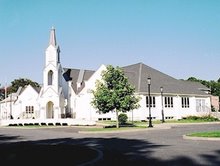As you can imagine, my plate is pretty full these days. This weekend we have the Annual Appeal for St. Luke’s School. Last year we raised over $36,000 for this cause. Granted it was our 50th Anniversary which certainly helped our cause. It is my hope that our school can continue to flourish as we seek to teach as Jesus taught. Please be generous to this worthy cause. Our enrollment is up and we are off to a good start.
I have been following the complex health care debate going on in Washington. It is my fervent hope that universal health care can be achieved for our citizens. This, after all, has been the call that has come from our U. S. bishops. Bishop William Murphy, chair of the bishops committee on Domestic Justice and Human Development wrote: “It is a fundamental issue of human life and dignity.” So far I have been encouraged that what is being proposed is “abortion neutral”. Any direct funding of abortion by the federal government would be wrong. There is so much at stake at this time. The health care debate calls us to prayer, dialogue and civility. This is literally a matter of life and death for so many.
Lastly, we are looking for people to head up our evangelization efforts here in the parish. On October 10 at Providence College there will be a conference. The day will include opportunities for prayer, major presentations, and discussion on this important topic. If interested please call me at the rectory.
Fr. Bob Hawkins
Saturday, September 19, 2009
Monday, September 07, 2009
Catholic teaching on cremation - Sept 7, 2009
I get frequent calls concerning the practice of cremation. The following article was written by Paul Turner, a noted liturgist. I found it very helpful and I hope you find it the same.
Fr. Bob Hawkins
Fr. Bob Hawkins
Cremation
Catholic Church law used to forbid cremation, but it now makes allowance for the practice. The church recommends that the bodies of the faithful be buried, but it permitscremation if the reasons for choosing that method are not contrary to Christian teaching. Viewing the body of the deceased naturally recalls the person’s deeds of kindness and testimony of faith. It brings to mind our belief that the human body is a temple of the Holy Spirit and the heir to glory at the resurrection of the dead. Because of the reverence owed the body, the Catholic Church still prefers its burial at the time of death. When cremation is chosen, the remains merit the same respect accorded to the body. They deserve a worthy vessel and a respectful means of transport. There are several options for the funeral liturgy. For example, the liturgy may take place before cremation, so the community may pray in the presence of the body. In that case, the rite of committal would follow cremation. In other cases, cremation and committal may precede the funeral Mass. The funeral liturgy may also happen in the presence of the cremated remains, if permitted by the diocesan bishop. In that case, the Mass proceeds as usual, but covering the remains with a pall is omitted. The church strongly recommends that cremated remains be buried in a grave or entombed in a mausoleum or columbarium rather than scattered or kept in a private home. Public cemeteries call to mind the resurrection of the dead and focus our prayer for the deceased.
